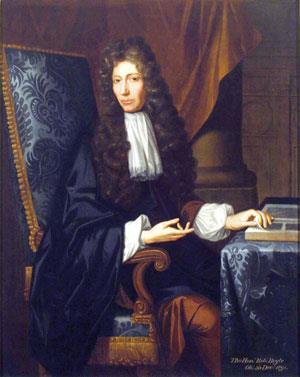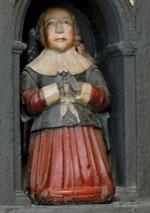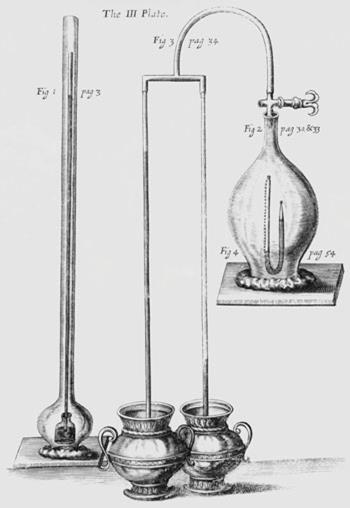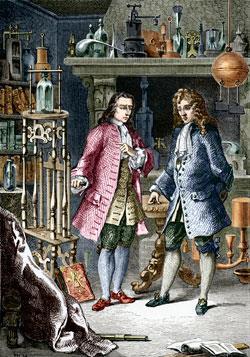Robert Boyle's The sceptical chymist still holds lessons for the modern chemist – 350 years after its publication, as Mike Sutton discovers
In 1660, Robert Boyle would not have seemed the ideal candidate to launch a chemical revolution. He was a shy man with fragile health, poor eyesight and a stammer. Civil war and regime change had disrupted his formal education. And although he had wide-ranging scholarly interests, his early writings were mostly literary and theological. He only became interested in the sciences during his twenties, and the prospect of new medicines for his numerous ailments drew him especially to chemistry. Even so, his chemical expertise remained little known outside a small circle of friends.

It was only at the insistence of several of these friends that in 1661 Boyle reluctantly published The sceptical chymist. 350 years later, many of its ideas have been discarded and its rambling conversational style seems inappropriate for an academic publication. Yet it still has lessons for us. Boyle’s dogged pursuit of reproducible results, and his rejection of obscure terminology, helped transform the speculative ’chymistry’ of his day into the experimentally grounded chemistry of ours.
Robert was born in 1627, the seventh son and fourteenth child of Richard Boyle, first Earl of Cork. His mother Catherine, the Earl’s second wife, died in 1630. By then Richard - an English adventurer who had arrived in Ireland in 1588 with few assets apart from his wits - was one of the kingdom’s wealthiest landowners. He sent Robert and his elder brother Francis to school at Eton for four years, before dispatching them (with a French Protestant tutor) on an extended study tour of Europe in 1639.
They were visiting Italy when civil war broke out between Charles I and his disaffected subjects in 1642. Francis returned to join his elder brothers fighting for the King. Robert continued studying in Geneva until the family’s financial difficulties compelled him to come home in 1644. Still barely old enough for soldiering and clearly unsuited for it, he took refuge with his sister Katherine, Viscountess Ranelagh.

Katherine’s piety and learning were widely renowned. Her London house was a meeting place for pro-Parliament intellectuals (including the poet John Milton, who became her son’s tutor), and her political connections later helped to reconcile some of her Royalist relatives with the emerging Cromwellian regime. However, it was her scientific connections that proved important for the apolitical Robert.
Robert withdrew to a small family property in Wiltshire, UK, in 1645, but remained a frequent visitor at his sister’s house. By 1647 she had introduced him to a network of scholars centred on the German Protestant exile Samuel Hartlib. The programme for the advancement of learning which Francis Bacon had promoted earlier in the century was their inspiration. Their aim was to gather knowledge about the physical universe through experimental investigations, and to apply it for the benefit of all humankind.
Early experiments
From his early twenties, Boyle was committed to these ideals. He quickly established a laboratory in his home and began corresponding with other investigators, though his prolific writings were still as much concerned with religion as with science. However, his research intensified after 1652, when he took lodgings in Oxford, UK. There, he met regularly with another group of experimentalists convened by the mathematician John Wilkins. Its members included the multi-talented Christopher Wren and Boyle’s gifted assistant, Robert Hooke.

Using an improved air pump built for him by Hooke, Boyle began to study the physics of gases. The results appeared in 1660 as New experiments physico-mechanical touching the spring of the air and its effects, and provoked a lively controversy. Soon afterwards, he stated for the first time the inverse relationship between gas pressure and volume we now call ’Boyle’s law’.
Elemental ideas
Although Oxford remained his home until 1668, Boyle visited London regularly and attended the inaugural meeting of the Royal Society there in 1660. Several of the society’s founders shared Bacon’s (and Hartlib’s) utopian aspirations, but the newly restored Charles II lacked the funds to establish the research institute they hoped for. Nevertheless, the society became a stimulating forum for scientific debate. And one highly debatable question was the identity of the fundamental elements which make up the complex substances we encounter in everyday life.

To appreciate Boyle’s position on this issue we must first consider the ideas he was opposing - beginning, inevitably, with Aristotle. Aristotle’s cosmology had been fatally challenged by the astronomical discoveries of Galileo, but his doctrine that terrestrial matter was composed of only four elements remained widely accepted. An often-cited ’demonstration’ was that a freshly-cut piece of wood, if sufficiently heated, releases flames (fire), moisture (water) and vapour (air), leaving behind ash (earth).
This satisfied many academics whose main concern was logical argument and rhetorical exposition, for Aristotle was still acknowledged as ’the greatest master of logic that ever lived’. Artisans who worked more closely with changeable substances - dyers, potters, distillers and metal-smelters - had other ideas. But since their craft knowledge was commercially valuable, they frequently concealed it in misleading language.
The alchemists who claimed to have perfected (or almost perfected!) the art of transmuting base metals into gold were even more secretive. Their recipes were wrapped in elaborate metaphors and embellished with reports of mystical revelations, although careful readers like Boyle extracted useful chemical information from them. And even though Boyle thought that most alchemists were fools or frauds, he still believed transmutation was possible and attempted it - unsuccessfully - himself.
Neither academic nor artisan, Boyle belonged to a new hybrid species - the hands-on scholars who could read learned texts, but were also at home in a workshop. However, the task closest to his heart was discovering new medicines - an activity which had been revolutionised during the previous century by the Swiss-German physician Paracelsus and his followers.
The Paracelsians frequently condemned university medical schools and city apothecaries’ guilds as incompetent monopolists whose drugs did more harm than good. But eventually some of the Pararacelsians’ new remedies were grudging accepted by the medical establishment - particularly when they appeared to outperform officially sanctioned ones.
These occasional successes may well have been due to Paracelsus’ insistence that physicians should rely more on observation and experience, and less on centuries-old textbooks. Later innovators - including Joannes Baptista van Helmont, a Flemish scholar from whom Boyle learned much - adopted Paracelsus’ empirical approach despite disagreeing with many of his theories.
Challenging principles
Paracelsus had argued that all matter contained three fundamental ’principles’ - sulfur, mercury and salt. These were not the familiar substances known by those names, but their far more elusive essences. ’Philosophic sulfur’ was the principle of inflammability, ’philosophic mercury’ the principle of fluidity, and ’philosophic salt’ the principle of hardness and incombustibility. And like the Aristotelians, the Paracelsians believed that analysis by fire vindicated their system.
Boyle - no stranger to the furnace himself - disagreed with both factions. But while his own ideas slowly matured, England’s politics grew more volatile. During the period between Cromwell’s death in 1658 and the restoration of Charles II in 1660, it was often unclear whether a republic or a monarchy would prevail. And when every national institution was threatened with sudden change, even a chemical treatise might have political implications.
Boyle’s university friends hustled him into releasing what he believed was a premature publication. We cannot be sure why they were so insistent, but we do know that in the late 1650s educational reform was a contentious issue. Only Cromwell’s death prevented the inauguration of a new university at Durham - a potential rival which Oxford and Cambridge united to suppress even before the monarchy was restored.
Puritans like John Webster had attacked the old universities bitterly. His 1653 Academiarum examen (An examination of the academies) condemned their outdated curriculum, calling for the introduction of new disciplines - including Paracelsian ’chymistry’. A ’Laboratory for Chymical Experiments’ was also planned at Durham’s new college. Wilkins’ Oxford friends rejected Aristotelianism and were sympathetic to new scientific initiatives, but their more conservative colleagues may have feared an invasion of radical Paracelsians.
A sceptical chemist
Fortunately The sceptical chymist was as conciliatory as Boyle himself, who insisted in his preface that ’a man may be a champion of truth without being an enemy to civility’. The unnamed narrator recounts an extremely civil discussion - modelled on Galileo’s famous Dialogue on the two great world systems - involving four participants. The Aristotelian Themistius and the Paracelsian Philoponus state their positions briefly, but soon fall silent. A wide-ranging discussion then follows between the sceptical Carneades and Eleutherius, the open-minded enquirer. This eventually turns into a lecture by Carneades.

On the identity of the elements, Carneades (clearly speaking for Boyle) has two contentions. Firstly he argues - citing many experimental examples - that the Aristotelian four-element system and the Paracelsian three-principle model give equally inadequate explanations of what happens when complex substances are attacked by fire, or by powerful solvents. He shows that these processes often generate new compounds, rather than the promised ’primitive and simple, or perfectly unmingled bodies’, which remain stubbornly elusive.
His second proposal is more speculative - and theologically more dangerous. Boyle believed, and hoped to prove in time, that the ultimate constituents of bodies were minute atoms, differing only in ’bulk, figure, texture and motion’. This idea was first suggested by the ancient Greek natural philosophers Leucippus and Democritus. Their successor, Epicurus, incorporated it into a godless materialistic world-view which was universally condemned by Christian theologians. Consequently, atomistic theories were swept under the carpet for centuries.
However, by the mid-17th century the works of the classical Greek atomists had been printed, translated and commented upon by scholars like the French astronomer Pierre Gassendi. There was still considerable hostility to them from clergy of all persuasions. But Boyle - a devout (though somewhat unorthodox) Christian who funded translations of the Gospels into many languages, including Gaelic and Turkish - saw no reason why a benign deity could not have chosen to create an atomic universe.
If Boyle were with us today, he would probably be delighted by the interlocking modules of Lego. They provide a helpful image of the kind of universe he was contemplating - full of diversity and constructed with only a few varieties of building block. Our own atomic (and subatomic) Lego kit now contains many more pieces than Boyle dreamed of - and yet our world-picture still has its roots in his.
Lasting lessons
Boyle deserves to be remembered as more than a theoretician. His understanding of chemistry came primarily from his own laboratory experience, not from the books of ancient authors or the folklore of artisans. His experiments were repeated until the results were consistent, and the failures and the successes were described with equal honesty. Moreover, unlike the ’chymists’ who preceded him, he wrote them up in plain and unambiguous language. In this way, too, he set precedents westill strive to follow.
Some of the experiments he recounts in The sceptical chymist remain familiar to modern students. For example, having suggested that a helpful classification of chemical compounds might be based on the differences between acids, alkalis and neutral substances, he goes on to describe dyes which display different colours in acid and alkaline solutions - an important step towards the development of reliable pH indicators.
Nevertheless, most readers today find the book hard going. Its rambling structure is very different from the linear narratives we are used to in modern textbooks, and many of its conclusions seem disappointingly inconclusive. Yet although its subtitle refers pointedly to the ’physico-chemical doubts and paradoxes’ which were still troubling Boyle when he reluctantly delivered it to the printer, we should not dismiss it as a failure. The sceptical chymist is a fascinating report on ’work in progress’, and therein lies its continuing relevance. For in Boyle’s era the science of chemistry was ’work in progress’ - and today, it still is.
Mike Sutton is a visiting fellow in the department of humanities at Northumbria University, UK
Further Reading
-
Boyle, The sceptical chymist, London 1661 (Dover Edition, New York 2003)
-
W Brock, Fontana history of chemistry, London 1992
-
M Hunter, Boyle: between god and science, Yale University Press 2009 (reviewed in Chemistry World, March 2010)
-
T Levere, Transforming matter: a history of chemistry from alchemy to the buckyball, Baltimore 2001
-
L Principe, The aspiring adept: Robert Boyle and his alchemical quest, Princeton 2000
-
C Webster, The great instauration, London 1975












No comments yet